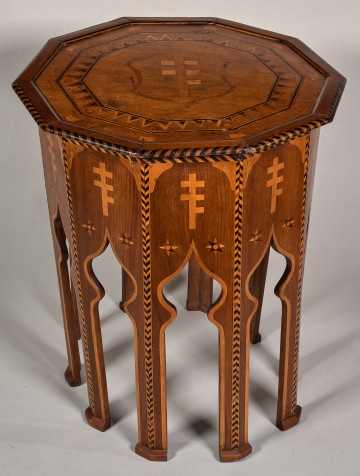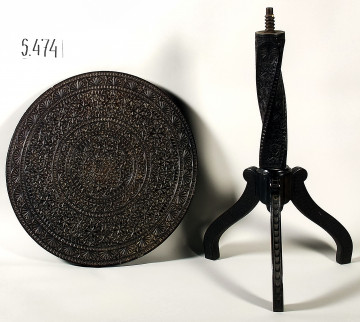
A table on ten legs
XIX century
Castle Museum in Łańcut
Part of the collection: Meble i wyposażenie wnętrz
The baroque vestibule wardrobes were always a luxurious piece of furniture. It most often fulfilled the function of a wardrobe for clothing set up in a vestibule, a representative hallway or corridor. This type of furniture, produced in northern Europe from the second half of the 17th to the end of the 18th century, reflected the social status of the owner. They were called Gdańsk, Dutch, Nuremberg, Hamburg, Frankfurt and Elbląg wardrobes, depending on the place of manufacture. It is worth remembering that Gdańsk wardrobes were among the most magnificent. The individual places of manufacture were mainly recognisable by their finishing techniques and choice of decorative details. The vestibule wardrobes were designed in a similar manner. It was always a chest-like piece of furniture with a body usually with two doors (from the front), fastened with an upper and lower rim, often, but not necessarily, with one or two drawers in the base section. The presented wardrobe does not have a pronounced opening in the top panel – a characteristic element of a Gdańsk wardrobe. It is distinguished by the straight line of the protruding moulding - typical of Hamburg wardrobes. On the other hand, the intarsia, incorporated on the inside of the door, was a common decorative element in Gdańsk wardrobes.
Teresa Bagińska-Żurawska https://orcid.org/0000-0002-9243-3967
Author / creator
Object type
furniture
Technique
stolarskie, metaloplastyka
Material
wood, mahogany wood, nut wood, brass, Żelazo
Creation time / dating
Creation / finding place
Owner
Muzeum - Zamek w Łańcucie
Identification number
Location / status

XIX century
Castle Museum in Łańcut

1. połowa XIX wieku
Castle Museum in Łańcut

połowa XIX wieku
Castle Museum in Łańcut
DISCOVER this TOPIC
Castle Museum in Łańcut
DISCOVER this PATH
Educational path